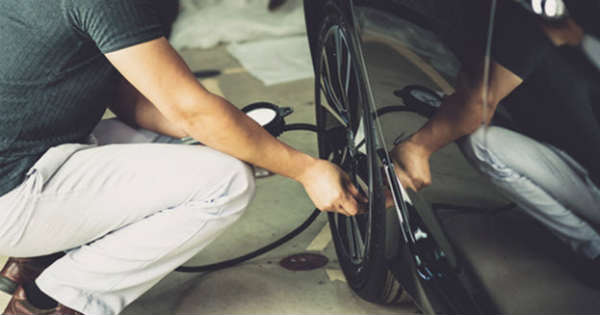ires can be one of the more expensive items on your car maintenance to-do list, but you can cut these costs significantly by taking steps to make them last longer. For example, one new all-season tire, on average, costs $140 — installation included — and can reach as high as $200, according to CostHelper, Inc. However, just one new winter tire will run you more — to the tune of $550 — and a typical tire for a 14- to 18-inch diameter wheel has a treadwear warranty between 40,000 and 100,000 miles, or two to five years, whichever comes first. Fortunately, you can stretch out the life of your tire and save thousands of dollars on your vehicle by following some simple but important steps if you want tires last longer.

1. Go Easy on Your Brakes
One of the simplest ways to make your tires last longer is to go easy on your brakes while driving. Hard braking and acceleration reduce your tire traction over time. In fact, each time you apply your brakes, the part of your tire that`s in contact with the road slides against the pavement for several feet, which gradually wears down your tires.
Additionally, excessive braking can also wear down your drive shaft and brake tubes. To avoid unnecessary damage to your tires and other parts of your car, apply your brakes and accelerator smoothly whenever possible. For instance, if you`re approaching a stop sign, you might take your foot off the accelerator early and let your car slow down before you apply the brakes to reduce wear on your tires.
2. Check Your Tire Pressure and Tread Depth
Want to make your tires last longer? Then you’ll want to check your tire pressure and tread depth frequently. That’s because tires lose air pressure over time due to temperature, altitude, tire wall impact and a host of other reasons. However, you can find your tire`s recommended air pressure level by consulting your owner`s manual, the tire placard mounted on your vehicle`s door edge, or your tire`s sidewall.
To check the air pressure, locate your tire pressure gauge, remove your tire valve cap, and insert the gauge into the valve. For the most accurate results, check your pressure when your tires have been sitting for a while, since driving causes the air inside to heat up and expand. You’ll want to do this at least once a month, or ideally, every other time you fill up your gas tank.
While you`re checking your tire pressure, it`s also a good idea to also check your tire tread depth, which is the distance between the top of the tire`s rubber tread and the bottom of its deepest grooves. Of course, as tires wear down over time, it will take more effort and time to brake, which can be dangerous for you and other fellow drivers. You can also be fined for driving on “bald” tires, which are considered to be worn down to a tread depth of 2/32 of an inch or less.
However, you can easily check your tread depth by inserting a penny or a quarter upside down into your tire`s grooves and seeing if President Lincoln or Washington`s head is covered. If you can see the top of each president`s head, then you’ll need to get a set of new tires. Most people use a penny, which will tell you if your tires have worn to 2/32 of an inch, but using a quarter will let you know when your tires have worn to 4/32 of an inch, which is safer.
3. Rotate and Balance Your Tires
The tread depth on your tires will be uneven due to the fact that one or two tires tend to do more work, such as the front tires in front-wheel drive vehicles. Ultimately, this will shorten the life of your tires, in addition to affecting your car`s handling and potentially violating your manufacturer`s warranty.
To offset this uneven wear, it`s important to get your tires rotated and balanced regularly. In fact, rotating your tires typically involves switching your rear and front tires, which evens out wear and tear. You should follow the guidelines in your owner`s manual to determine how often to rotate your tires, with a typical rotation interval of every 7,500 miles, or every six months.
Meantime, a mechanic can work to balance your tires, which involves spinning the tires to test for and eliminate vibrations that reflect uneven performance. Most owner`s manuals recommend balancing your tires every 5,000 to 7,500 miles, so it`s a good practice to balance them every time you get your tires rotated.
When rotating and balancing your tires, it`s also a good opportunity to check your wheel alignment. Of course, having an uneven wheel misalignment can cause your car to drift in one direction when you steer, promoting uneven tire wear. When a mechanic aligns your wheels, they check to make sure the tilt of your wheels tracks evenly in all directions. Thus, a best practice is to check your alignment whenever you purchase new tires and when you take them in to be rotated and balanced.
Save Wear and Tear on Your Tires
You can make your tires last longer by following three simple daily, monthly and bi-annual rules of thumb. For example, each day you drive your car, make it a point to go easy on your brakes, which will save everyday wear and tear on your tires. Then, by checking your tire pressure and tread at least once a month, you’ll know if one or more tires is experiencing any issues.
Finally, get in the habit of rotating and balancing your tires as well as checking your wheel alignment twice a year, which can help prevent any tire maintenance issues. Ultimately, following these practices will extend the life of your tires, saving you thousands of dollars over the lifetime of your vehicle.

